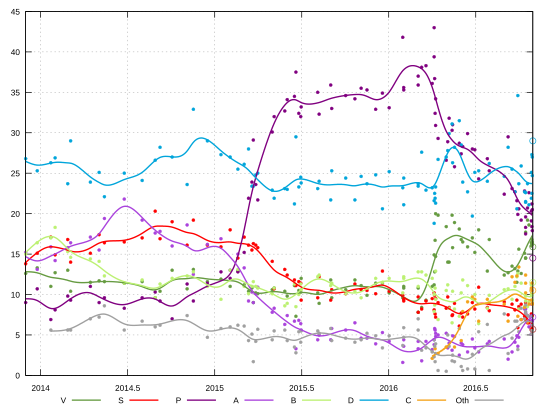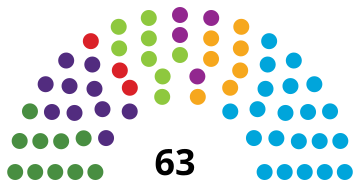|
||||||||||||||||||||||||||||||||||||||||||||||||||||||||||||||||||||||||||||||||||||||||||||||||||||||||||||||||||||||||||||||||||||||||||||||||
|
||||||||||||||||||||||||||||||||||||||||||||||||||||||||||||||||||||||||||||||||||||||||||||||||||||||||||||||||||||||||||||||||||||||||||||||||
|
||||||||||||||||||||||||||||||||||||||||||||||||||||||||||||||||||||||||||||||||||||||||||||||||||||||||||||||||||||||||||||||||||||||||||||||||
The Independence Party emerged as the largest in the Althing, winning 21 of the 63 seats; the Progressive Party, which had won the most seats in 2013, lost more than half its seats as it was overtaken by the Left-Green Movement and the Pirate Party. Of the 63 elected MPs, 30 were female, giving Iceland the highest proportion of female MPs in Europe.[4]Parliamentary elections were held in Iceland on 29 October 2016. They were due to be held on or before 27 April 2017, but following the 2016 Icelandic anti-government protests, the ruling coalition announced that early elections would be held “in autumn”.
Background[edit]
In early April 2016, following revelations in the Panama Papers, leaks from law firm Mossack Fonseca about the financial dealings of then Prime Minister Sigmundur Davíð Gunnlaugsson(Progressive Party) and his wife, there were calls for an early election from the opposition,[5] who planned to present him with a motion of no confidence. Mass protests calling on the Prime Minister to quit followed. Although Sigmundur Davíð had stated he had no intention of resigning, he apparently resigned on 5 April. However, it was later stated by the Prime Minister’s office that he had only taken a temporary leave of absence from his duties.[6][7][5][8][9] The Progressive Party’s deputy leader, Sigurður Ingi Jóhannsson, became acting Prime Minister the same day.[9]
The President, Olafur Ragnar Grimsson, then said he would speak to both coalition parties, Progressive Party and Independence Party, before considering whether to call new elections.[10] Opposition parties continued to press for new elections.[8] On 6 April, Sigurður announced, “We expect to have elections this autumn.”[11] On 11 August, Bjarni Benediktssonmet with opposition parties and later announced that elections would be held on 29 October 2016.[3]
Electoral system[edit]
The 63 members of the Althing were elected using closed list proportional representation in multi-member constituencies of 8 to 13 seats.[12] Of the 63 seats, 54 were elected using constituency results and determined using the d’Hondt method. The remaining nine supplementary seats were awarded to parties that crossed the 5% national electoral threshold in order to give them a total number of seats equivalent to their national share of the vote.[12]
Participating parties[edit]
The final deadline for parties to apply for participation in the parliamentary election was 14 October 2016.
- Parties with a list for all constituencies
- Bright Future, list letter A
- Progressive Party, list letter B
- Viðreisn, list letter C
- Independence Party, list letter D
- People’s Party, list letter F
- Social Democratic Alliance, list letter S
- Dawn, list letter T
- Left-Green Movement, list letter V
- Pirate Party, list letter P
- Parties with a list for only some constituencies
- Humanist Party in Reykjavík South, list letter H
- People’s Front of Iceland in all constituencies apart from the Northwest, list letter R
- Icelandic National Front in the South and Northwest constituencies, list letter E
Campaign[edit]
Sigurður Ingi replaced Sigmundur Davíð as the party chairman of the Progressive Party on 2 October 2016.[13]
The Pirate Party announced on 16 October 2016 that they would not participate in post-election negotiations to form a coalition government with either the Progressive Party or the Independence Party.[14] The party did send letters to Viðreisn, Bright Future, Social Democratic Alliance and Left-Green Movement about the possibility of forming an alliance prior to the election.[14]
Opinion polls[edit]

Graphical summary of the opinion polls in Iceland since the previous parliamentary election. Each dot corresponds to one poll’s number for party. A smoothing spline is used to show the trends. The scatter of points around the spline curves gives an indication of the uncertainty of the polls. The thin circles at the very right show the results of the election, which for P and D deviate significantly from the polls.
| Institute | Release date | V | S | P | A | B | D | C | Others |
|---|---|---|---|---|---|---|---|---|---|
| 2016 result | 29 Oct 2016 | 15.91% | 5.74% | 14.48% | 7.25% | 11.49% | 29.00% | 10.48% | 5.74% |
| Gallup | 28 Oct 2016 | 16.5% | 7.4% | 17.9% | 6.8% | 9.3% | 27.0% | 8.8% | |
| MMR | 28 Oct 2016 | 16.2% | 6.1% | 20.5% | 6.7% | 11.4% | 24.7% | 8.9% | 5.5% |
| Háskóli Íslands | 27 Oct 2016 | 16.8% | 5.7% | 21.2% | 6.7% | 10.1% | 22.5% | 11.4% | 5.5% |
| Fréttablaðið / Stöð 2 / Vísir | 27 Oct 2016 | 16.4% | 5.7% | 18.4% | 6.3% | 9.9% | 27.3% | 10.5% | 5.5% |
| MMR | 26 Oct 2016 | 16.0% | 7.6% | 19.1% | 8.8% | 10.0% | 21.9% | 9.3% | 7.3% |
| Fréttablaðið / Stöð 2 / Vísir | 26 Oct 2016 | 16.4% | 6.0% | 20.3% | 5.1% | 11.2% | 25.1% | 10.8% | 5.1% |
| Háskóli Íslands | 21 Oct 2016 | 18.6% | 6.5% | 22.6% | 6.0% | 9.1% | 21.1% | 8.8% | 7.3% |
| Fréttablaðið / Stöð 2 / Vísir | 18 Oct 2016 | 19.2% | 6.5% | 20.7% | 7.4% | 8.5% | 23.7% | 6.6% | 7.4% |
| MMR | 14 Oct 2016 | 14.5% | 9.0% | 19.6% | 8.2% | 9.2% | 21.4% | 10.2% | 7.9% |
| Háskóli Íslands | 14 Oct 2016 | 17.7% | 6.9% | 17.5% | 7.7% | 8.6% | 21.5% | 11.4% | 8.7% |
| Gallup | 14 Oct 2016 | 14.5% | 7.1% | 18.3% | 7.7% | 9.8% | 22.6% | 12.4% | 7.6% |
| Fréttablaðið / Stöð 2 / Vísir | 12 Oct 2016 | 15.1% | 7.3% | 22.8% | 8.2% | 8.5% | 22.7% | 8.4% | 7.0% |
| Fréttablaðið / Stöð 2 / Vísir | 5 Oct 2016 | 12.6% | 8.8% | 19.2% | 6.9% | 11.4% | 25.9% | 6.9% | 8.3% |
| Gallup | 30 Sep 2016 | 15.6% | 8.5% | 20.6% | 4.7% | 8.2% | 23.7% | 13.4% | 5.4% |
| Fréttablaðið / Stöð 2 / Vísir | 28 Sep 2016 | 12.9% | 5.9% | 19.9% | 3.6% | 12.6% | 34.6% | 7.3% | 3.2% |
| MMR | 26 Sep 2016 | 11.5% | 9.3% | 21.6% | 4.9% | 12.2% | 20.6% | 12.3% | 6.7% |
| MMR | 22 Sep 2016 | 13.2% | 8.1% | 22.7% | 4.1% | 11.0% | 22.7% | 11.5% | 6.7% |
| Gallup | 16 Sep 2016 | 13.5% | 8.8% | 23.1% | 2.9% | 9.4% | 25.5% | 12.2% | 4.6% |
| Fréttablaðið / Stöð 2 / Vísir | 8 Sep 2016 | 12.7% | 7.5% | 29.5% | 2.0% | 10.7% | 28.2% | 6.7% | 2.7% |
| Gallup | 6 Sep 2016 | 16.2% | 8.3% | 25.8% | 2.9% | 9.0% | 26.3% | 10.6% | 0.9% |
| MMR | 30 Aug 2016 | 12.4% | 9.1% | 22.4% | 4.5% | 10.6% | 24.6% | 8.8% | 7.6% |
| Gallup | 29 Jul 2016 | 16.8% | 8.0% | 25.3% | 4.2% | 9.9% | 26.2% | 9.0% | 0.6% |
| MMR | 25 Jul 2016 | 12.9% | 8.4% | 26.8% | 3.9% | 8.3% | 24.0% | 9.4% | 6.3% |
| MMR | 7 Jul 2016 | 18.0% | 10.9% | 24.3% | 2.9% | 6.4% | 25.3% | 6.7% | 5.4% |
| Gallup | 29 Jun 2016 | 15.2% | 8.2% | 27.9% | 3.4% | 10.0% | 25.1% | 9.4% | 0.8% |
| Háskóli Íslands | 24 Jun 2016 | 17.0% | 9.0% | 28.0% | 4.5% | 9.5% | 19.7% | 9.7% | 2.6% |
| Háskóli Íslands | 14 Jun 2016 | 15.9% | 7.6% | 29.9% | 2.9% | 11.1% | 22.7% | 9.1% | 0.8% |
| Háskóli Íslands | 4 Jun 2016 | 16.5% | 7.2% | 28.3% | 3.8% | 11.8% | 23.9% | 7.9% | 0.6% |
| Gallup | 1 Jun 2016 | 16.8% | 7.7% | 27.4% | 4.0% | 10.2% | 28.5% | 4.3% | 1.1% |
| Fréttablaðið / Stöð 2 / Vísir | 27 May 2016 | 18.1% | 6.1% | 28.7% | 2.5% | 7.3% | 31.5% | 5.8% | |
| Háskóli Íslands | 17 May 2016 | 18.9% | 8.9% | 25.8% | 4.8% | 8.2% | 28.2% | 3.5% | 1.7% |
| MMR | 13 May 2016 | 15.8% | 7.5% | 31.0% | 4.9% | 10.4% | 26.3% | 2.5% | |
| Fréttablaðið | 12 May 2016 | 19.8% | 7.4% | 30.3% | 3.1% | 6.5% | 31.1% | 1.8% | |
| Fréttablaðið | 6 May 2016 | 14.0% | 8.4% | 31.8% | 4.0% | 8.3% | 29.9% | 3.6% | |
| MMR | 3 May 2016 | 14.0% | 9.7% | 28.9% | 3.4% | 11.2% | 27.8% | 5.0% | |
| Gallup | 30 Apr 2016 | 18.4% | 8.3% | 26.6% | 5.2% | 10.5% | 27.0% | 3.5% | 0.5% |
| Gallup | 13 Apr 2016 | 19.8% | 9.0% | 29.3% | 5.0% | 6.9% | 26.7% | 2.7% | 0.6% |
| Háskóli Íslands | 8 Apr 2016 | 14.7% | 9.5% | 30.9% | 4.8% | 12.9% | 23.3% | 3.9% | |
| Maskína | 8 Apr 2016 | 20.0% | 7.2% | 34.2% | 5.2% | 9.4% | 21.3% | 2.7% | |
| Gallup | 7 Apr 2016 | 16.7% | 7.6% | 32.4% | 5.6% | 10.8% | 21.9% | 3.3% | 1.7% |
| MMR | 6 Apr 2016 | 12.8% | 9.9% | 36.7% | 5.8% | 8.7% | 22.5% | 3.6% | |
| Fréttablaðið | 5 Apr 2016 | 11.2% | 10.2% | 43.0% | 3.8% | 7.9% | 21.6% | 2.3% | |
| Háskóli Íslands | 5 Apr 2016 | 14.9% | 8.1% | 39.4% | 4.4% | 10.0% | 18.8% | 4.4% | |
| Gallup | 31 Mar 2016 | 11.0% | 9.5% | 36.1% | 3.2% | 12.0% | 23.2% | 2.1% | 2.9% |
| MMR | 18 Mar 2016 | 9.3% | 9.2% | 38.3% | 4.2% | 12.4% | 22.9% | 3.4% | |
| Fréttablaðið | 9 Mar 2016 | 8.4% | 8.2% | 38.1% | 1.8% | 12.8% | 27.6% | 3.1% | |
| MMR | 2 Mar 2016 | 7.8% | 7.8% | 37.0% | 4.2% | 12.8% | 23.4% | 7% | |
| Gallup | 2 Mar 2016 | 10.8% | 9.7% | 35.9% | 3.3% | 11.0% | 23.7% | 5.6% | |
| Gallup | 2 Feb 2016 | 10.8% | 9.2% | 35.3% | 3.6% | 12.0% | 24.4% | 4.7% | |
| MMR | 2 Feb 2016 | 11.0% | 9.4% | 35.6% | 4.4% | 12.2% | 21.1% | 5.9% | |
| Fréttablaðið | 30 Jan 2016 | 9.6% | 9.9% | 41.8% | 1.6% | 10.2% | 23.2% | 3.7% | |
| Gallup | 2 Jan 2016 | 10.2% | 10.4% | 33.1% | 4.2% | 12.0% | 25.2% | 4.9% | |
| MMR | 18 Dec 2015 | 11.4% | 12.9% | 34.9% | 5.3% | 11.5% | 20.6% | 3.4% | |
| Gallup | 4 Dec 2015 | 11.4% | 10.1% | 32.9% | 3.9% | 12.0% | 24.8% | 4.9% | |
| MMR | 16 Nov 2015 | 9.9% | 10.5% | 35.3% | 4.6% | 10.8% | 23.7% | 5.2% | |
| Gallup | 4 Nov 2015 | 11.1% | 10.6% | 35.5% | 4.6% | 9.6% | 24.6% | 4.4% | |
| MMR | 21 Oct 2015 | 11.8% | 11.3% | 34.2% | 6.5% | 10.4% | 21.7% | 4.1% | |
| Gallup | 2 Oct 2015 | 10.6% | 10.1% | 34.6% | 5.6% | 10.1% | 24.4% | 4.6% | |
| MMR | 3 Sep 2015 | 9.6% | 10.6% | 33.0% | 5.8% | 11.4% | 25.3% | 4.3% | |
| Gallup | 1 Sep 2015 | 11.8% | 9.3% | 35.9% | 4.4% | 11.1% | 21.7% | 5.8% | |
| Gallup | 7 Aug 2015 | 8.9% | 12.2% | 32.3% | 5.0% | 12.4% | 24.0% | 5.2% | |
| MMR | 4 Aug 2015 | 10.2% | 9.6% | 35.0% | 4.4% | 12.2% | 23.1% | 5.5% | |
| MMR | 30 Jun 2015 | 12.0% | 9.3% | 33.2% | 5.6% | 10.6% | 23.8% | 5.5% | |
| Rúv | 29 Jun 2015 | 10.3% | 11.4% | 32.0% | 6.4% | 11.3% | 24.5% | 4.1% | |
| MMR | 25 Jun 2015 | 10.5% | 11.6% | 32.4% | 6.8% | 10.0% | 23.3% | 5.4% | |
| FBL | 19 Jun 2015 | 7.3% | 11.1% | 37.5% | 3.3% | 8.5% | 29.5% | 2.8% | |
| MMR | 16 Jun 2015 | 11.1% | 11.8% | 34.5% | 6.7% | 11.3% | 21.2% | 3.5% | |
| Gallup | 1 Jun 2015 | 9.8% | 12.4% | 34.1% | 7.4% | 8.9% | 23.0% | 4.3% | |
| MMR | 26 May 2015 | 10.4% | 13.1% | 32.7% | 6.3% | 8.6% | 23.1% | 5.6% | |
| MMR | 4 May 2015 | 10.8% | 10.7% | 32.0% | 8.3% | 10.8% | 21.9% | 5.5% | |
| Gallup | 30 Apr 2015 | 10.6% | 14.1% | 30.1% | 7.8% | 10.1% | 22.9% | 4.4% | |
| Gallup | 30 Mar 2015 | 10.1% | 15.8% | 21.7% | 10.9% | 10.8% | 25.0% | 5.7% | |
| Kjarninn | 26 Mar 2015 | 10.2% | 16.1% | 23.6% | 10.1% | 11.0% | 24.8% | 4.2% | |
| MMR | 21 Mar 2015 | 9.0% | 16.3% | 29.1% | 9.0% | 11.6% | 23.4% | 1.7% | |
| MMR | 18 Mar 2015 | 10.8% | 15.5% | 23.9% | 10.3% | 11.0% | 23.4% | 5.1% | |
| Fréttablaðið | 11 Mar 2015 | 10.4% | 16.1% | 21.9% | 9.2% | 10.1% | 28.0% | 4.3% | |
| Rúv | 2 Mar 2015 | 11.2% | 17.1% | 15.2% | 13.3% | 11.0% | 26.1% | 6.1% | |
| MMR | 19 Feb 2015 | 12.9% | 14.5% | 12.8% | 15.0% | 13.1% | 25.5% | 6.2% | |
| Gallup | 3 Feb 2015 | 11.0% | 18.0% | 12.0% | 13.0% | 13.0% | 27.0% | 6.0% | |
| MMR | 14 Jan 2015 | 11.9% | 15.9% | 12.8% | 16.9% | 9.4% | 27.3% | 5.8% | |
| Mbl | 16 Dec 2014 | 11.6% | 16.1% | 11.4% | 16.2% | 11.0% | 29.0% | 4.7% | |
| Fréttablaðið | 17 Nov 2014 | 13.1% | 19.2% | 9.2% | 12.5% | 12.8% | 32.9% | ||
| MMR | 4 Nov 2014 | 10.7% | 16.1% | 11.3% | 18.6% | 12.3% | 23.6% | 7.4% | |
| Gallup | 3 Oct 2014 | 13.0% | 19.0% | 7.0% | 16.0% | 12.0% | 27.0% | ||
| MMR | 8 Sep 2014 | 10.4% | 16.9% | 9.2% | 17.8% | 11.3% | 28.2% | 6.2% | |
| MMR | 28 Aug 2014 | 9.6% | 20.3% | 10.3% | 17.6% | 9.6% | 26.6% | 6.0% | |
| MMR | 31 Jul 2014 | 11.6% | 17.0% | 9.6% | 19.2% | 11.8% | 24.1% | 6.7% | |
| MMR | 24 Jun 2014 | 11.4% | 16.5% | 8.3% | 21.8% | 11.4% | 25.0% | 5.6% | |
| MMR | 13 May 2014 | 11.6% | 16.4% | 9.6% | 19.4% | 12.3% | 22.1% | 8.6% | |
| MMR | 2 May 2014 | 11.7% | 17.4% | 9.0% | 15.5% | 14.1% | 25.1% | 7.2% | |
| MMR | 14 Apr 2014 | 11.5% | 15.1% | 11.0% | 17.1% | 14.4% | 23.9% | 7.0% | |
| MMR | 3 Mar 2014 | 10.4% | 14.0% | 9.3% | 16.4% | 14.6% | 29.0% | 5.6% | |
| RÚV | 27 Feb 2014 | 13.0% | 16.8% | 9.8% | 15.8% | 15.3% | 23.7% | 5.6% | |
| Capacent | 1 Feb 2014 | 12.7% | 14.9% | 8.1% | 14.2% | 18.3% | 26.9% | ||
| MMR | 22 Jan 2014 | 11.0% | 17.1% | 6.9% | 15.9% | 17.0% | 26.3% | 5.6% | |
| Capacent | 24 Dec 2013 | 13.3% | 15.1% | 10.7% | 13.1% | 16.4% | 25.3% | ||
| MMR | 30 Nov 2013 | 12.6% | 13.8% | 9.0% | 15.2% | 15.0% | 26.8% | ||
| 2013 result | 28 Apr 2013 | 10.87% | 12.85% | 5.10% | 8.25% | 24.43% | 26.70% | ||
| Institute | Release date | V | S | P | A | B | D | C | Others |
Results[edit]
| Party | Votes | % | Seats | +/– | |
|---|---|---|---|---|---|
| D | Independence Party | 54,990 | 29.00 | 21 | +2 |
| V | Left-Green Movement | 30,166 | 15.91 | 10 | +3 |
| P | Pirate Party | 27,449 | 14.48 | 10 | +7 |
| B | Progressive Party | 21,791 | 11.49 | 8 | –11 |
| C | Viðreisn | 19,870 | 10.48 | 7 | New |
| A | Bright Future | 13,578 | 7.16 | 4 | –2 |
| S | Social Democratic Alliance | 10,893 | 5.74 | 3 | –6 |
| F | People’s Party | 6,707 | 3.54 | 0 | New |
| T | Dawn | 3,275 | 1.73 | 0 | 0 |
| R | People’s Front of Iceland | 575 | 0.30 | 0 | 0 |
| E | Icelandic National Front | 303 | 0.16 | 0 | New |
| H | Humanist Party | 33 | 0.02 | 0 | 0 |
| Invalid/blank votes | 5,574 | – | – | – | |
| Total | 195,204 | 100 | 63 | 0 | |
| Registered voters/turnout | 246,515 | 79.19 | – | – | |
| Source: Iceland Monitor | |||||
This was the lowest turnout in Iceland’s history.[15]
Government formation[edit]
Neither of the two main blocs — the outgoing coalition of Independence and Progressive parties, or the Pirates and allies (Left-Green Movement, Bright Future and Social Democrats) — secured an overall majority, leaving the new Viðreisn party as possible ‘kingmakers’.[16]
The Independence Party were expected to take the lead in forming a new government, with their party leader, Bjarni, expressing preference for a three-party coalition, although without saying which three parties. The Pirate Party, while significantly up on the last election, did less well than polls had previously suggested they might. They proposed a five-party coalition with the Left-Green Movement, the Social Democrats, Bright Future and Viðreisn, having previously ruled out working with either of the two outgoing coalition members.[4] The Pirate Party then suggested a minority coalition of Left-Green Movement, Bright Future and Viðreisn, with support but not ministerial representation from themselves and the Social Democrats, in order to simplify the process of government.[17]
The leader of Viðreisn ruled out a right-leaning three-party coalition with Independence and the Progressives.[18] Viðreisn have not ruled out supporting the Pirates bloc.






